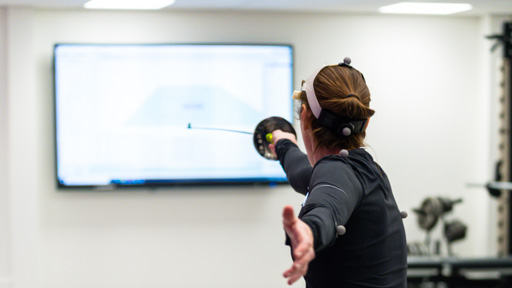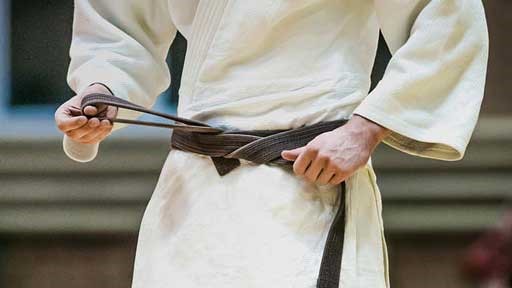Fencing
High Performance Sport Research Group
Our research group aims to perform research in high performance sport such as fencing, judo and the female athlete. We have extensive research being performed in the areas of elite fencing and judo working alongside the national governing bodies and international bodies. We also perform research in other areas such as genetics of injury such as concussion. The recently built state of the art Institute of Sport building helps us perform world class research in the area of high-performance sport.
Members of this group embrace varied domains of sports and exercise related research including: exercise physiology, genetics, coaching, and sports nutrition.
What we provide
- Knowledge and skills in high performance sport research
- Elite level expertise and knowledge of fencing and judo
- A forum for collaboration and research mentoring
- First class research facilities
- Postgraduate research supervision
- Space to stay up to date with one another and our wider networks
Case studies
Background
Fencing is an intermittent sport with three weapon categories: sabre, épée, and foil. During a fight, fencers undertake multiple explosive actions (particularly lunging movements) to outscore their opponent. Typical work to rest ratios of 1:1.2 are observed for épée, 1:3 for foil, and 1:6.5 for sabre, whereby fencers will work for an average of 10, 5, and 2.5 s per action, respectively. Therefore, there are distinct differences between the weapon categories; sabre is more explosive, whereas épée has a greater submaximal component. Differences between weapons are primarily due to the specific rules of the sport, whereby foil and sabre observe a priority system, where starting the first attack is important for scoring. Épée has no priority system, and the tactics therefore produce longer phases during a bout. International fencing competitions last between 1 and 3 days. Although each competition day can last up to 12 h, of which the actual fencing time has been estimated between 5 and 15% of the competition day.
There is limited research within the sport fencing and being an open skilled sport involving a lot of equipment, it presents a lot of angles for research from a physiological, psychological and technical perspective.
What did the researchers do?
We worked with British Fencing on performing research to help inform the trans gender inclusion policy. This involved conducting a narrative review on the topic focusing on the physiological differences between males and females and the difficulties of hormone therapy. We are currently conducting a survey-based study exploring the view of the members on the best way for inclusion within the sport. We also have been doing research to explore responses to different environmental temperatures to help inform the BF heat policy. Finally, we have been doing some work with the world leading fencing equipment supplier Leon Paul to help explore any physiological and perceptual differences of thermal responses to the face with different fencing masks.

What has the research found?
All this work is ongoing. However, the narrative review on trans women participation in fencing can be found here.
Find out more
Feel free to contact Dr Lindsay Bottoms to find out more.
Genetics in High Performance Sport
Background
It is well established within the scientific community that genetic characteristics are fundamental to success in elite sport. We know from heredity and familial studies that physical and physiological traits can be largely determined via genetics. For example, muscle strength and aerobic capacity have been shown to be 50% heritable and this value increases further for musculo-skeletal injury such as anterior cruciate ligament ruptures, which have a ~70% heritability estimate. However, although we know that genetics plays a key role in determining success within elite sport, what the research is not clear on are the individual or combined DNA (deoxyribonucleic acid) variants that contribute to this heritability. Perhaps where it may be easiest to identify DNA variants that contribute to sporting performance are at the elite ends of the human spectrum i.e., elite athletes. One area that is known to have a detrimental effect on achieving elite status in sport is injury. Elite rugby has one of the highest injury risks of any professional sport. Therefore, we wanted to investigate if there was a genetic contribution to injury risk within elite male rugby.
What did the researchers do?
Firstly, we reviewed the current research to identify DNA variants that had been previously linked to musculo-skeletal injury, and concussion. From this we identified multiple DNA variants that could be investigated. We then collected blood and saliva samples, as well as injury data from over 700 elite rugby athletes across the world as part of project GENESIS and compared their DNA variants to a control sample of 1000 individuals.

What has the research found?
In this body of work, we found:
- Elite rugby athletes are more likely to carry DNA variants that are considered ‘protective’ from musculo-skeletal and concussion injury.
- The total genotype score was able to distinguish between elite rugby athletes and non-athletes.
- Collagen related genesproduced the best model for predicting elite athlete status in rugby.
- Elite rugby athletes might possess an inherited resistance to soft-tissue and concussion injury, which has enabled them to achieve elite status despite exposure to the high-risk environment of elite rugby.
Find out more
There is ongoing research into the genetic contribution to performance and injury risk, as well as how this may influence health related traits. Feel free to contact Jon Brazier to find out more.
High Performance Sport of Judo
Background
Judo is a combat sport and education that is a widely practiced in many countries worldwide, and millions of people participate in judo activities. The sport's international governing body, the International Judo Federation (IJF), boasts a membership that includes national judo federations from over 200 countries. International competitions, including the Olympic Games and World Championships, draw athletes, coaches, referees and spectators from across the world.
The University of Hertfordshire hosts the i-dojo, a research unit established to provide a home for international judo research. The mission is ‘to benefit society through the development of high-quality evidence-based understanding to impact on the management, coaching and practice of the way of judo’. Our partners are the International Judo Federation Academy who provide officially recognised qualifications to judo coaches. Their qualification is the required level to provide coaching at any event on the IJF World Tour.
We deliver the Judo Research Induction Course (J-RES) in partnership with the IJF Academy to prepare judo coaches to extend their knowledge at the highest level through postgraduate study.
What did the researchers do?
Our researchers are investigating a range of topics relevant to high-performance, including;
- Impact of Kodokan Judo Techniques in Winning Medals at the yearly peak events 2018 Judo World Championships in Baku AZE and 2019 Judo World Championships in Tokyo JPN.
- The road to Tokyo: A case study of leadership, athlete-centred coaching and skill training periodisation in Olympic judo.
- To what extent are the International Judo Federation Safe Sport (Safeguarding) policies, procedures and operational practices able to meet the responsibilities of an International Federation?
- A study on the impact of the competition rule changes on the result of the bronze medal fight in international judo and its relationship with the International Judo World Ranking Lists.
- How expert teachers understand the application of rhythm in judo

What has the research found?
A number of important findings have emerged from the research.
- A new model of coaching judo based on rhythm has been developed, the PSRM approach.
- Four recognised throwing techniques were identified which are banned in matches, the IJF Sports and Organisation Rules were updated as a result and the new rule set will be in place for the 2024 Paris Olympic Games.
- We are currently working on a review of the policies and procedures that protect vulnerable adults from harm whilst the compete in international judo.
Find out more
Our research into aspects of high-performance judo continues to evolve, for the latest information contact Associate Professor Mike Callan.